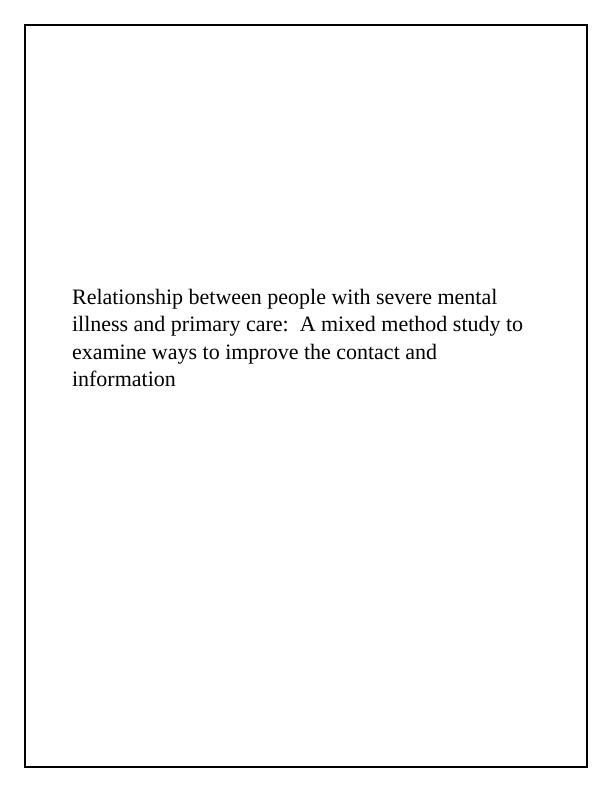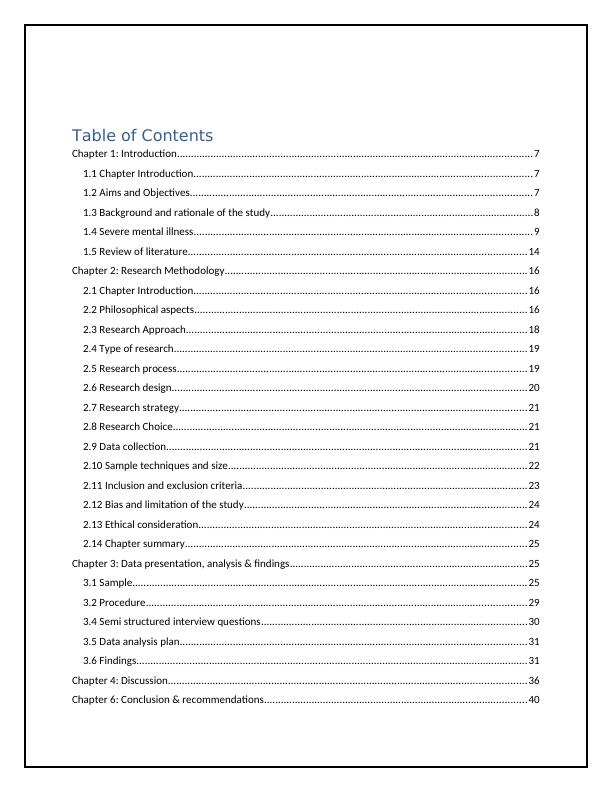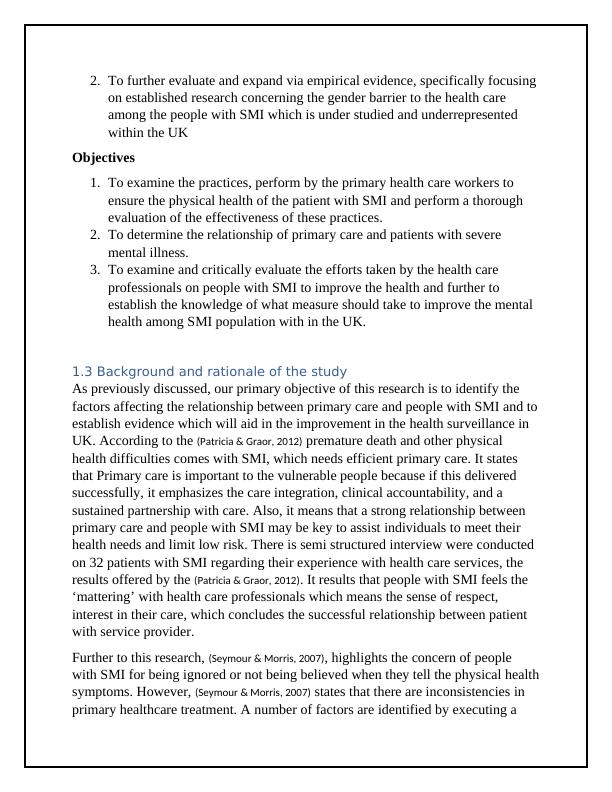Relationship between people with severe mental illness and primary care
Added on 2022-12-22
49 Pages15535 Words1 Views
Relationship between people with severe mental
illness and primary care: A mixed method study to
examine ways to improve the contact and
information
illness and primary care: A mixed method study to
examine ways to improve the contact and
information

Acknowledgement
It gives me immense pleasure to finally present my dissertation “Relationship
between people with severe mental illness and primary care: A mixed method
study to examine ways to improve the contact and information”. This research
topic has helped me to gain ample knowledge in this field of study. I wish to
extend my most sincere gratitude to all those who helped to make this dissertation
a reality. I am especially grateful to my supervisor who helped me extensively in
this study. I would like to also extend my gratitude to all my friends and classmates
whose assistance proved to be milestone in accomplishing my final goal. I
acknowledge their constant support in the fulfillment of this dissertation. Needless
to say, I alone am responsible for any shortcomings in this project.
It gives me immense pleasure to finally present my dissertation “Relationship
between people with severe mental illness and primary care: A mixed method
study to examine ways to improve the contact and information”. This research
topic has helped me to gain ample knowledge in this field of study. I wish to
extend my most sincere gratitude to all those who helped to make this dissertation
a reality. I am especially grateful to my supervisor who helped me extensively in
this study. I would like to also extend my gratitude to all my friends and classmates
whose assistance proved to be milestone in accomplishing my final goal. I
acknowledge their constant support in the fulfillment of this dissertation. Needless
to say, I alone am responsible for any shortcomings in this project.

Abstract
Even there is relationship of primary care with severe mental illness patients exist,
still person with severe mental illness are more likely to be undertreated and seek
care in emergency ward. The goal of this study is to obtain the in-depth details of
barriers to primary care for people with SMI and to provide the solutions to these
barriers. In this qualitative interview’s method are used to interview the mental
health nurses or primary care as well as patient with SMI. Several factors reported
in this research like poor access to care, untrained specialists, communication
difficulties, patient limitations, and quality of care. In results, Nursing professional
needs to improve the continue access the medical care of this patients and as well
as continue to integrate the mental health and primary care. The process of
engagement such as mattering, being perceived as capable, working together.
Further research should explore the relationship in primary care with SMI people
from the prospective of the providers. As per this, there are quantitative method are
used in this. Thus, this helps to provide the significance of the statistic. The
numerical data are evaluated in order to create the evidence based data. This data
used to provide the epidemiological preset data.
Even there is relationship of primary care with severe mental illness patients exist,
still person with severe mental illness are more likely to be undertreated and seek
care in emergency ward. The goal of this study is to obtain the in-depth details of
barriers to primary care for people with SMI and to provide the solutions to these
barriers. In this qualitative interview’s method are used to interview the mental
health nurses or primary care as well as patient with SMI. Several factors reported
in this research like poor access to care, untrained specialists, communication
difficulties, patient limitations, and quality of care. In results, Nursing professional
needs to improve the continue access the medical care of this patients and as well
as continue to integrate the mental health and primary care. The process of
engagement such as mattering, being perceived as capable, working together.
Further research should explore the relationship in primary care with SMI people
from the prospective of the providers. As per this, there are quantitative method are
used in this. Thus, this helps to provide the significance of the statistic. The
numerical data are evaluated in order to create the evidence based data. This data
used to provide the epidemiological preset data.

Table of Contents
Chapter 1: Introduction...............................................................................................................................7
1.1 Chapter Introduction.........................................................................................................................7
1.2 Aims and Objectives..........................................................................................................................7
1.3 Background and rationale of the study..............................................................................................8
1.4 Severe mental illness.........................................................................................................................9
1.5 Review of literature.........................................................................................................................14
Chapter 2: Research Methodology............................................................................................................16
2.1 Chapter Introduction.......................................................................................................................16
2.2 Philosophical aspects.......................................................................................................................16
2.3 Research Approach..........................................................................................................................18
2.4 Type of research..............................................................................................................................19
2.5 Research process.............................................................................................................................19
2.6 Research design...............................................................................................................................20
2.7 Research strategy............................................................................................................................21
2.8 Research Choice...............................................................................................................................21
2.9 Data collection.................................................................................................................................21
2.10 Sample techniques and size...........................................................................................................22
2.11 Inclusion and exclusion criteria......................................................................................................23
2.12 Bias and limitation of the study.....................................................................................................24
2.13 Ethical consideration.....................................................................................................................24
2.14 Chapter summary..........................................................................................................................25
Chapter 3: Data presentation, analysis & findings.....................................................................................25
3.1 Sample.............................................................................................................................................25
3.2 Procedure........................................................................................................................................29
3.4 Semi structured interview questions...............................................................................................30
3.5 Data analysis plan............................................................................................................................31
3.6 Findings............................................................................................................................................31
Chapter 4: Discussion................................................................................................................................36
Chapter 6: Conclusion & recommendations..............................................................................................40
Chapter 1: Introduction...............................................................................................................................7
1.1 Chapter Introduction.........................................................................................................................7
1.2 Aims and Objectives..........................................................................................................................7
1.3 Background and rationale of the study..............................................................................................8
1.4 Severe mental illness.........................................................................................................................9
1.5 Review of literature.........................................................................................................................14
Chapter 2: Research Methodology............................................................................................................16
2.1 Chapter Introduction.......................................................................................................................16
2.2 Philosophical aspects.......................................................................................................................16
2.3 Research Approach..........................................................................................................................18
2.4 Type of research..............................................................................................................................19
2.5 Research process.............................................................................................................................19
2.6 Research design...............................................................................................................................20
2.7 Research strategy............................................................................................................................21
2.8 Research Choice...............................................................................................................................21
2.9 Data collection.................................................................................................................................21
2.10 Sample techniques and size...........................................................................................................22
2.11 Inclusion and exclusion criteria......................................................................................................23
2.12 Bias and limitation of the study.....................................................................................................24
2.13 Ethical consideration.....................................................................................................................24
2.14 Chapter summary..........................................................................................................................25
Chapter 3: Data presentation, analysis & findings.....................................................................................25
3.1 Sample.............................................................................................................................................25
3.2 Procedure........................................................................................................................................29
3.4 Semi structured interview questions...............................................................................................30
3.5 Data analysis plan............................................................................................................................31
3.6 Findings............................................................................................................................................31
Chapter 4: Discussion................................................................................................................................36
Chapter 6: Conclusion & recommendations..............................................................................................40

6.1 Conclusion.......................................................................................................................................40
6.2 Recommendations...........................................................................................................................40
References.................................................................................................................................................41
6.2 Recommendations...........................................................................................................................40
References.................................................................................................................................................41

Figure 1 Proportion of patients in 5 countries...........................................................................................11
Figure 2 research methodologies used......................................................................................................16
Figure 3 Types of research philosophy......................................................................................................17
Figure 4 Research design process flow......................................................................................................20
Figure 5 Inclusion and exclusion Criteria...................................................................................................23
Figure 6 Gender of participants.................................................................................................................26
Figure 7 Age of Participants.......................................................................................................................26
Figure 8 Ethnicity of Participants...............................................................................................................27
Figure 9 Participants marital status...........................................................................................................28
Figure 10 Participants educational background.........................................................................................29
Figure 11 finding Categories......................................................................................................................32
Figure 2 research methodologies used......................................................................................................16
Figure 3 Types of research philosophy......................................................................................................17
Figure 4 Research design process flow......................................................................................................20
Figure 5 Inclusion and exclusion Criteria...................................................................................................23
Figure 6 Gender of participants.................................................................................................................26
Figure 7 Age of Participants.......................................................................................................................26
Figure 8 Ethnicity of Participants...............................................................................................................27
Figure 9 Participants marital status...........................................................................................................28
Figure 10 Participants educational background.........................................................................................29
Figure 11 finding Categories......................................................................................................................32

Chapter 1: Introduction
1.1 Chapter Introduction
Literature review is a systematic process in which the recent scholarly papers are
reviewed so that the study or research can be done in effective manner. In this
chapter, researcher discussed about the mental disorders in primary care. Also,
symptoms and diagnosis of mental health has been mentioned. Also, researcher
reviews some literature and discussed in this chapter. Lastly, significance, rationale
of the study, gap in literature has been mentioned (Mantovani 2020).
1.2 Aims and Objectives
According to the (Hardy & Gray, 2010)It is the duty of healthcare professional in health
care center or primary care to monitor the physical/mental health of the people in
UK. However, there is no specific professional training given to these health care
professionals to do this practice efficiently. But, according to the (Reilly, et al., 2012),
there are primary research has been conducted to evaluate the structural processes
of Severe mental illness health care. This research statement will play an important
role to shape the primary objective of this research, in which there is evaluation of
relationship between primary healthcare center and people with SMI and also lack
of significant research will be evaluated.
Aims
1. To develop a clear understanding of the barriers to the primary care
experienced by the people with SMI such as depressions, bi-polar disorder,
eating disorders, schizophrenia via the utilization of empirical data which is
associated with the mental health.
1.1 Chapter Introduction
Literature review is a systematic process in which the recent scholarly papers are
reviewed so that the study or research can be done in effective manner. In this
chapter, researcher discussed about the mental disorders in primary care. Also,
symptoms and diagnosis of mental health has been mentioned. Also, researcher
reviews some literature and discussed in this chapter. Lastly, significance, rationale
of the study, gap in literature has been mentioned (Mantovani 2020).
1.2 Aims and Objectives
According to the (Hardy & Gray, 2010)It is the duty of healthcare professional in health
care center or primary care to monitor the physical/mental health of the people in
UK. However, there is no specific professional training given to these health care
professionals to do this practice efficiently. But, according to the (Reilly, et al., 2012),
there are primary research has been conducted to evaluate the structural processes
of Severe mental illness health care. This research statement will play an important
role to shape the primary objective of this research, in which there is evaluation of
relationship between primary healthcare center and people with SMI and also lack
of significant research will be evaluated.
Aims
1. To develop a clear understanding of the barriers to the primary care
experienced by the people with SMI such as depressions, bi-polar disorder,
eating disorders, schizophrenia via the utilization of empirical data which is
associated with the mental health.

2. To further evaluate and expand via empirical evidence, specifically focusing
on established research concerning the gender barrier to the health care
among the people with SMI which is under studied and underrepresented
within the UK
Objectives
1. To examine the practices, perform by the primary health care workers to
ensure the physical health of the patient with SMI and perform a thorough
evaluation of the effectiveness of these practices.
2. To determine the relationship of primary care and patients with severe
mental illness.
3. To examine and critically evaluate the efforts taken by the health care
professionals on people with SMI to improve the health and further to
establish the knowledge of what measure should take to improve the mental
health among SMI population with in the UK.
1.3 Background and rationale of the study
As previously discussed, our primary objective of this research is to identify the
factors affecting the relationship between primary care and people with SMI and to
establish evidence which will aid in the improvement in the health surveillance in
UK. According to the (Patricia & Graor, 2012) premature death and other physical
health difficulties comes with SMI, which needs efficient primary care. It states
that Primary care is important to the vulnerable people because if this delivered
successfully, it emphasizes the care integration, clinical accountability, and a
sustained partnership with care. Also, it means that a strong relationship between
primary care and people with SMI may be key to assist individuals to meet their
health needs and limit low risk. There is semi structured interview were conducted
on 32 patients with SMI regarding their experience with health care services, the
results offered by the (Patricia & Graor, 2012). It results that people with SMI feels the
‘mattering’ with health care professionals which means the sense of respect,
interest in their care, which concludes the successful relationship between patient
with service provider.
Further to this research, (Seymour & Morris, 2007), highlights the concern of people
with SMI for being ignored or not being believed when they tell the physical health
symptoms. However, (Seymour & Morris, 2007) states that there are inconsistencies in
primary healthcare treatment. A number of factors are identified by executing a
on established research concerning the gender barrier to the health care
among the people with SMI which is under studied and underrepresented
within the UK
Objectives
1. To examine the practices, perform by the primary health care workers to
ensure the physical health of the patient with SMI and perform a thorough
evaluation of the effectiveness of these practices.
2. To determine the relationship of primary care and patients with severe
mental illness.
3. To examine and critically evaluate the efforts taken by the health care
professionals on people with SMI to improve the health and further to
establish the knowledge of what measure should take to improve the mental
health among SMI population with in the UK.
1.3 Background and rationale of the study
As previously discussed, our primary objective of this research is to identify the
factors affecting the relationship between primary care and people with SMI and to
establish evidence which will aid in the improvement in the health surveillance in
UK. According to the (Patricia & Graor, 2012) premature death and other physical
health difficulties comes with SMI, which needs efficient primary care. It states
that Primary care is important to the vulnerable people because if this delivered
successfully, it emphasizes the care integration, clinical accountability, and a
sustained partnership with care. Also, it means that a strong relationship between
primary care and people with SMI may be key to assist individuals to meet their
health needs and limit low risk. There is semi structured interview were conducted
on 32 patients with SMI regarding their experience with health care services, the
results offered by the (Patricia & Graor, 2012). It results that people with SMI feels the
‘mattering’ with health care professionals which means the sense of respect,
interest in their care, which concludes the successful relationship between patient
with service provider.
Further to this research, (Seymour & Morris, 2007), highlights the concern of people
with SMI for being ignored or not being believed when they tell the physical health
symptoms. However, (Seymour & Morris, 2007) states that there are inconsistencies in
primary healthcare treatment. A number of factors are identified by executing a

End of preview
Want to access all the pages? Upload your documents or become a member.
Related Documents
Impact of Job Satisfaction on Employee Performance in Shell Oman Marketinglg...
|84
|15741
|414
Exploration of Biogas Generation in Rural Gujarat, Indialg...
|72
|23141
|129
Using Information Technology to bridge the gap between Irish Dieters and Irish Food Products and Serviceslg...
|70
|23236
|96
Customer Relationship Management in Primarklg...
|37
|13302
|125
Impact of Hard Brexit on HRM and Expat Employees in UK Retail Sectorlg...
|38
|9749
|51
Impact of Coupon System on Consumer Behavior in E-commerce Saleslg...
|38
|11255
|46
